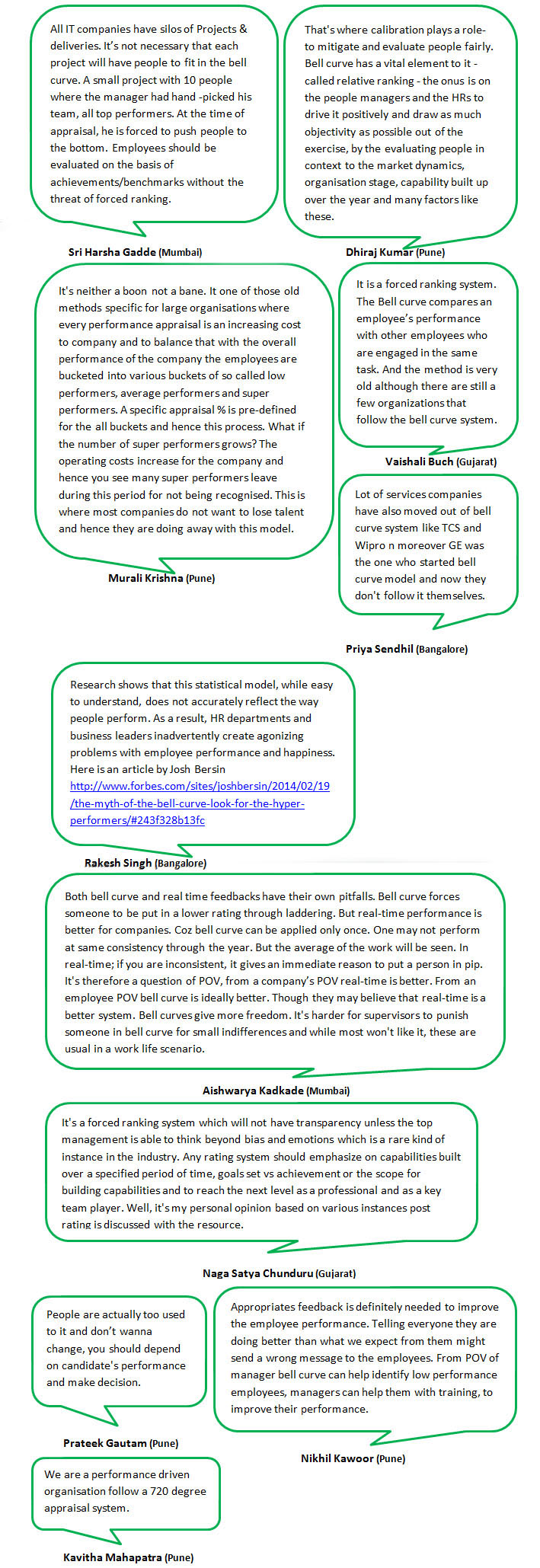Talent Acquisitionists look forward to the performance of a new joinee and have a certain level of performance expectation from the individual on-board. That said it’s obvious why they are constantly looking for a way to measure the Employees performance from an individual and an organisational level.
In view of that, our Pune group member Karnika suggested to have a discussion on, “Bell Curve Performance Management System a boon or bane?†with an attempt to find out how we can tackle the situation. Thus, @SourcingAdda we conducted our popular Wednesday discussion on the same and these are the insights we received…
Based on the discussion above, I’m sure you’d agree with us when we state that this was quite a discussion with many perspectives and aspects to look at. How great is that? If you’ve come this far, then you’ve certainly added to your knowledge. That being said, I’m certain that you’d like to grab the takeaways as a refresher to what you’ve learnt. So let’s not disappoint you anymore, hence here goes…
Bell Curve Performance Management
Bell Curve Performance Management as a Boon
- But real-time performance is better for companies
- From the POV of a Manager the bell curve system can help identify low performance Employees
- Managers can help low performance Employees with training to improve their performance
Bell Curve Performance Management as a Bane
- The bell curve model may be considered a rigid approach for rating employees
- Managers sometimes need to put employees in specific gradients due to the bell curve requirements; especially with small teams
- It creates doubts in the mind of both managers and employees such as the possibility of an exit during tough job market conditions
- Doubts lead to loss of morale and further deterioration of job performance
- It’s not suitable for small companies with less than 300 employees, the categorization isn’t done properly with mostly erroneous results
- Indian companies have either given up completely or increasingly moved away from the ‘Bell Curve System of Appraisal Model’
- The Bell Curve segregates all Employees into distinct baskets i.e. top, average (comprising of the vast majority) and bottom performers
- Compensation or hikes are also based on the rating given for any financial year
- The Categorization of the performance is done on annual basis
- Digitalised evaluations give better results in comparison to the Bell Curve System
- Most IT companies have several Projects & deliveries to cater to and it need not be that each project will have people to fit in the bell curve.
- A small project with 10 people where the Manager had a team with all top performers is forced to push people to the bottom during the appraisal process
- It’s neither a boon nor a bane; as it’s an old method that is specific for large organisations where every performance appraisal is an increasing CTC
- For the overall performance of the company and to balance the CTC the Employees are bucketed into various buckets called low performers, average performers and super performers
- A specific appraisal % is pre-defined for all buckets
- Bell curve forces someone to be put in a lower rating through laddering
- The operating costs increase for the company and many super performers leave during this period due to lack of recognition
- To prevent the loss of talent; organisations are doing away with this model thus the trend inclines towards doing away with this system altogether
- Research shows that this statistical model, while easy to understand, doesn’t accurately reflect performance
Bell Curve VS Real Time Feedbacks
- Both Bell Curve and Real – Time feedbacks have pitfalls highlighted below
Bell Curve Feedbacks
- Bell curve can be applied only once
- One may not perform at the same consistency throughout  the year
- You only see the average work done
Real Time Feedbacks
- If you are inconsistent then it gives an immediate reason to put a person in pip and it’s therefore a question of POV thus given below are the 2 types of POV expressed –
Company’s POV
- Real-Time is a better system
Employee’s POV
- Bell Curve is ideally better
- Bell Curves give more freedom
- It’s harder for Supervisors to punish someone in the bell curve system for small indifferences that are usual in a work-life scenario
Bell Curve Performance Management a General perspective
- The Bell Curve Model has a vital element to it – called relative ranking where the onus is on the People Managers and the HRs to drive it positively
- These individuals are responsible to draw as much objectivity as possible
- To gain objectivity; evaluating people in context to the market dynamics, organisation stage, capability built up over the year etc. is important
- The most important goal is to increase the overall performance of the company and Teamwork plays a vital role in achieving it
- Calibration plays a role in order to mitigate and evaluate people fairly
- It’s important to have good relation with Managers, if that’s established then which system a company follows doesn’t matter
Bell Curve Performance Management Possible Solutions / Improvements
- A simplistic approach by giving the manager more power and authority
- An old method which must be tweaked to accommodate new age demands
- Tools to judge the performance of individuals as well as the team as a whole is essential
- A holistic appraisal process based on individual performances is necessary
- Feedback should be systematic and periodic while considering individual contributions towards the team’s success is required
- A 360 degree feedback survey with monthly feedback sessions to be considered while evaluating Associates is essential
- More emphasis to be given to the sense of belongingness, loyalty, collaboration and teamwork
- Companies now follow monthly & quarterly evaluations as a precaution to avoid shocking situations with the individual and organization at the end of the year
- Technology has effectively improved ones performance
- A rise in the use of technology can be seen hence digitalizing the evaluations is required
- Digitalized evaluations help align the individual and organizational performance in real time
- Evaluations that are digitalized create a win-win situation where both sides are happy; yet  clear about the expectations
- Employees should be evaluated on the basis of achievements / benchmarks and without the threat of forced ranking i.e. doesn’t have transparency
- Top Management is required to think beyond bias and emotions which are rare instances in the industry
- Any rating system should emphasize on the scope for building capabilities that are built over a specified period of time, goals that are set vs achievement/s, reach the next level as a professional and on a key team player
- Post rating is discussed with the resource
- People don’t wanna change when they are used to a system
- Decision makers should depend on a candidate’s performance and then decide if the Employee deserves the appraisal
- Appropriate feedback is definitely needed to improve the employee performance
- A generalised approach that conveys the message that they are doing better than what we expect from them might send a wrong message to the Employees
Well this brings us to the end of an insightful and enlightening experience that we’re constantly on the look – out for, isn’t this great? You can gain different perspectives, add to your learning while staying updated with the current trends followed; live at our popular Wednesday discussions.
Want to get these perspectives and more in real – time then you absolutely need to join these insightful conversations. You can do this by following us @SourcingAdda; hence, leave your views or requests to be added to the various WhatsApp groups in our comments section.












